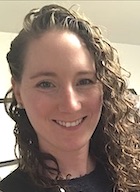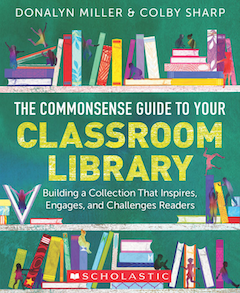Class Libraries to Inspire and Challenge Readers
The Commonsense Guide to Your Classroom Library: Building a Collection that Inspires, Engages, and Challenges Readers
By Colby Sharp and Donalyn Miller
(Scholastic, 2022 – Learn more)
Reviewed by Katie Durkin

From the beginning of my career as an educator, I had known that classroom libraries were an integral part of literacy instruction, especially for middle school kids, but I wanted to research ways to better help my colleagues and myself use them as a tool to engage and motivate middle school readers.

It’s a book I wish I’d had for my dissertation research. That said, I’m very glad to have it now to guide my current and future work with classroom libraries.
The catalyst for this book
Divided into four chapters, Miller and Sharp provide insight, wisdom, and actionable practices for teachers to use with their classroom libraries. Beginning with a short introduction, the authors lay out their purpose, specifically naming how the catalyst for this book was the Covid-19 pandemic.
As Miller and Sharp note, the pandemic created a crisis of book access for students. And the crisis also prompted Sharp to consider his own classroom library and to begin overhauling his collection for when students returned to the physical classroom.
The brainstorming Sharp and Miller did during this process eventually became this book. The long-time colleagues (and co-creators of the Nerdy Book Club community) wanted to share with readers how the processes they used to overhaul Sharp’s classroom library will help teachers think about ways to use these ideas in their own space.
The power of classroom libraries
Chapter 1 begins by providing a rationale for the need for classroom libraries. Miller and Sharp discuss all kinds of libraries – public, home, and school – and consider how they work in tandem with classroom libraries. I love that this chapter offers the arguments we need to convince our school colleagues and administrators that classroom libraries are in integral part of a complete literacy program.
All of Miller and Sharp’s assertions are backed by recent research. The authors make it clear that classroom libraries provide kids with easy access to more books than they are likely to encounter otherwise and will have a direct impact on students’ personal and communal reading lives.
Collecting and organizing in today’s climate
The majority of the book is taken up by chapter two, where Miller and Sharp focus on building a collection of books and the design and organization of a first-rate classroom library. They address many issues that teachers may encounter, including how to be purposeful in curating for the space.
The authors discuss four major tenets when creating a classroom library: (1) the quantity of books to have in the space; (2) the diversity of books, with considerations made for inclusivity, genres, topics, etc.; (3) the relevance and currency of books; (4) and finally, the organization of the space and how students will use it.
Miller and Sharp also discuss censorship and book banning – issues that currently plague many schools across the nation. I appreciated the resources and suggestions they had for how to handle book challenges, including advice from experts such as Becky Calzada. I felt that this chapter was the hallmark of the text, and I appreciated the thoroughness with which Miller and Sharp approached curating and organizing for a classroom library.
Making your library work for your students
The final two chapters of the book focus on using your class library with students. Chapter 3 was rich with ideas for helping kids grow as readers, drawn from practices Sharp uses with his own students. I left this chapter thinking about how I could adapt his ideas in my own space.
Chapter 4 focuses specifically on independent reading, sharing how a classroom library and teacher practices can be responsive to students’ interests and specific instructional needs. Sharp includes great ideas he personally uses in his classroom, including conferring, developing reading plans, and using surveys to help create a reading community. I once again found myself taking copious notes.
Insights from other professionals put into practice
There were three extra features that I loved most about this book. First, in each chapter the authors shared insights from professionals who are working to promote independent reading and classroom libraries. Miller and Sharp’s interviews with these professionals help us understand how the theory and pedagogy grounded in the book can be put into practice. I love when authors offer different perspectives like this, showing how their ideas can play out in diverse schools and classrooms.
Sharp also included anecdotes throughout the book about how ideas from the text functioned in his own space. This second feature was one I really enjoyed because I saw theory being put into practice, and I could see myself using what Sharp did with students in my own classroom.
Finally, at the end of each chapter, Miller and Sharp provide “Time to Reflect” questions where readers can think about how the ideas from each chapter can transfer to their own space and practices. This pushed me to think that this is not a book to be read in isolation. There are so many strategies that Miller and Sharp provide that I wanted to discuss and try out with my colleagues while reading the text.
I believe reading this book with a colleague or your department will help each teacher to push themselves as they come to see classroom libraries as living, breathing spaces and put Miller and Sharp’s ideas into practice.
Meeting classroom library challenges throughout your school
What I appreciated most about this book was Miller and Sharp’s honesty. Having a classroom library is a huge undertaking, and Miller and Sharp do not shy away from sharing the difficulties that they have personally experienced in their own practice.
The authors may have have tagged their book as “commonsense,” but I think they are pushing teachers to think further and deeper than we might otherwise about the impact classroom libraries can have on students.
They offer ready-to-use strategies for enhancing classroom libraries while also providing resources that are accessible to teachers. I would recommend this to any teacher, regardless of the subject you teach. I believe that Social Studies, Science, and (yes) Math classrooms can have classroom libraries that can help promote literacy and independent reading.
Curriculum coordinators and administrators would also benefit from reading this book. It will certainly help them understand the value of supporting classroom libraries. Miller and Sharp clearly lay out the need for such spaces and provide practical strategies for getting started.
Dr. Katie Durkin (@kmerz610) has been teaching middle school students for over a decade, and currently teaches English Language Arts at public Middlebrook School in Wilton, Connecticut, where she is the 7th Grade Team Leader.
Katie is a zealous reader of middle grade and young adult books and enjoys sharing her love and passion for reading with her students. In 2022 she earned her doctorate from Northeastern University. Katie was the 2020 recipient of the Edwyna Wheadon Postgraduate Training Scholarship from NCTE. She writes regularly for MiddleWeb.




































